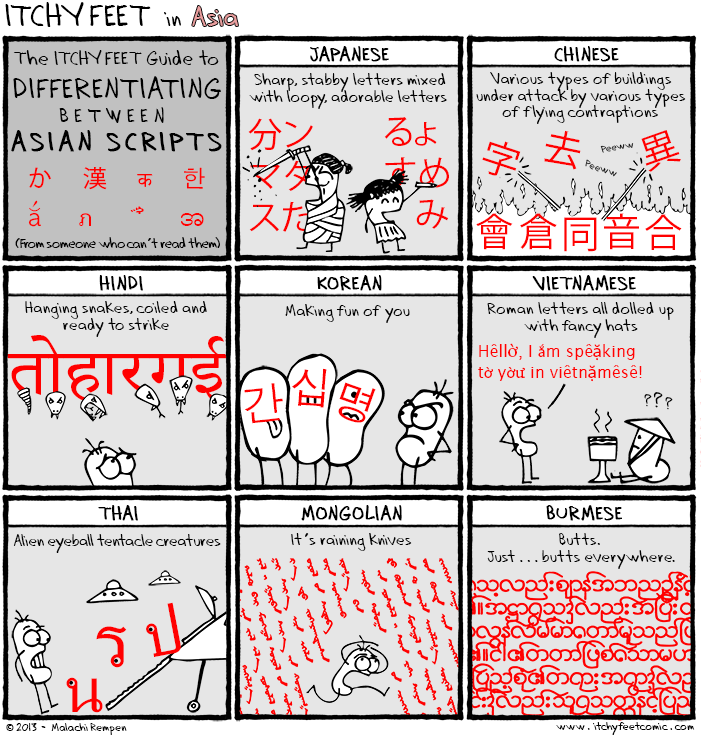Itchy Feet webcomic on Asian scripts
« previous post | next post »
This is from 2013, but it's been making the rounds on Facebook…

(Source)
Ingenious, thought-provoking comparisons.
Does the appearance of a given script convey any sort of distinctive meaning or feeling?
How do scripts develop to look the way they do?
Do scripts convey something about the people who designed and developed them?
Are scripts solely dependent on historical processes?
Just as scripts look and act very differently, so do languages sound and convey meaning in very different ways.
If I may say so, each language and each script has its own genius.
Incidentally, partly prompted by this post, I will make two additional posts that focus on Mongolian script and language within the next few days.
B.Ma said,
April 30, 2019 @ 7:51 pm
I wonder how the Latin script appears to people who can't read it, and there must be very few of them (that is, people who can read another script but not Latin) given that Pinyin etc. is taught in school and Latin characters appears on all sorts of items and signs. Even my grandparents could read it despite never becoming able to form English sentences longer than 2 words.
Victor Mair said,
April 30, 2019 @ 9:31 pm
"I wonder how the Latin script appears to people who can't read it"….
Bauhausian.
"The Modern Letter – The Best of the Bauhaus Typography"
Fundamentally functional.
unekdoud said,
May 1, 2019 @ 3:13 am
There's a different kind of distinctive feeling when the Chinese/Japanese scripts are imitated so often just for their appearance, to the point of being unreadable nonsense.
George Lane said,
May 1, 2019 @ 9:43 am
A Japanese scholar (writing in classical literary Japanese, so most likely pre-Meiji) described the western alphabet in quite unflattering terms, comparing the shapes of the letters to worms, snakes, and other vile things.
Unfortunately I don't know the author's name, the date or even the name of the journal where I read a translation of it, but as a 1st year student of Japanese, I found it amusing, so I hand-copied the original text (reproduced below, to the best of my ability). Pasting it into an online translator conveys the general sense fairly well.
今夫洋字之爲形。糾結佶屈蜿蜿双然、孖然。
直者如犬旡、圓者如蚓蟠。屈者如螳斧、伸者如蝸涎。
如枯。如朽顱。如死蛇腐蝮蝘之腊。
Robert L Greene said,
May 1, 2019 @ 11:03 am
@George Lane, I get a passable rendition when I paste this into Google Translate as Chinese (which is also what Google auto-detects) When I try it as translating from Japanese it is total gobbledygook. I'm guessing that means pre-Meiji Japanese drew heavily on Chiense styles, or something like that.
As "Chinese": The shape of the present foreign language is shaped. Tangle and sorrow, stunned. Straight ones are like dogs, and those who are round are like a donkey. The bender is like an axe, and the stretcher is like a worm. As dry. Such as the skull. Such as dead snakes rotten wax.
As "Japanese": Imao Yo-ji form.糾 佶 蜿 蜿 stunned. If you are a dog man, you are a man. Kusunoki Ruka, Shinya Ruka. Thank you. Roh.死 蛇.
Chris Button said,
May 1, 2019 @ 8:16 pm
Regarding Burmese, to quote Chas. Duroiselle on page 8 of volume 1 of Epigraphia Birmanica (1919): "The old Burmese alphabet as we find it in the Myazedi has become, through a series of gradual and slow changes, the modern Burmese alphabet as used now. There was always a perceptible tendency to round off the more or less angular and square letters into soft curves and circles or parts of circles; but for these general changes and some others, few but more radical, as for instance in the subscript letters h and m, the old and modern alphabets are practically identical."
Pete said,
May 2, 2019 @ 9:06 am
@B.Ma – The Latin script (to someone who can't read it) probably looks very like the Cyrillic script (to someone who can't read that), or to a lesser extent Greek.
Or if you want to know how Latin would look to someone who totally unfamiliar with western scripts, have a look at Armenian. It has the same principles of capital and lower-case letters, with ascenders, descenders, serifs and so on, but with completely unfamiliar letter forms.
Richard Miller said,
May 3, 2019 @ 5:20 pm
If I remember correctly, it was not unusual in 18th century Japan to refer to cursive roman script as "cow piss" or "cow piss on a wall." I don't recall the context now, but I think it was as part of a general comedic take on foreigners in popular culture, such as having characters in the theater speak "Chinese" that consisted of strings of syllables modeled after Buddhist scripture reading. I believe there is still a fabric pattern called "cow piss" that looks something like lines of cursive roman script.